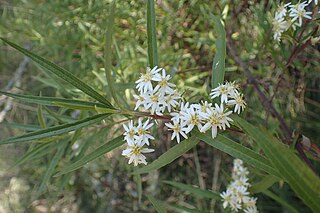
Olearia axillaris, commonly known as coastal daisy-bush, coast daisy-bush or coastal daisybush is a species of flowering plant in the family Asteraceae and is endemic to coastal areas of Australia. It is an erect, bushy shrub with densely cottony-hairy branchlets, aromatic, linear to narrowly elliptic or narrowly lance-shaped to egg-shaped leaves with the narrower end towards the base and small white and yellow, daisy-like inflorescences.

Olearia viscidula, commonly known as the viscid daisy bush or wallaby weed, is a species of flowering plant in the family Asteraceae and is endemic to eastern New South Wales. It is a shrub with scattered narrow elliptic or egg-shaped leaves that are paler on the lower surface, and panicles of white flowers arranged in leaf axils.

Olearia asterotricha, commonly known as rough daisy-bush, is a species of flowering plant in the family Asteraceae. A tall shrub with white, mauve or blue daisy like flowers growing from the Blue Mountains in New South Wales to western Victoria, Australia.

Olearia canescens is a species of flowering plant in the family Asteraceae and is endemic to eastern Australia. It is a shrub with scattered elliptic or egg-shaped leaves, and white and yellow, daisy-like inflorescences.

Olearia ballii, commonly known as mountain daisy, is a species of flowering plant in the family Asteraceae and is endemic to Lord Howe Island. It is a dense shrub with crowded linear leaves and small, purplish and white, daisy-like inflorescences.

Thryptomene denticulata is a shrub species in the family Myrtaceae that is endemic to Western Australia.

Boronia gracilipes, commonly known as karri boronia, is a plant in the citrus family, Rutaceae and is endemic to the south-west of Western Australia. It is an erect, spindly shrub with compound leaves and pink, four-petalled flowers.
Olearia adenolasia, commonly known as woolly-glandular daisy-bush, is a species of flowering plant in the family Asteraceae. It is a small upright shrub with sticky leaves and blue-purple or white daisy flowers.

Olearia magniflora, commonly known as the splendid daisy-bush, is a small shrub with clusters of deep mauve to purple flowers.

Olearia ciliata, commonly known as the fringed daisy bush, is a small shrub with large clusters of bright purple-blue flowers on a single stem.

Olearia oppositifolia is a species of flowering plant in the family Asteraceae and is endemic to eastern Australia. It is a shrub with egg-shaped to elliptic leaves arranged in opposite pairs, and white and yellow daisy flowers.

Hibbertia desmophylla is a species of flowering plant in the family Dilleniaceae and is endemic to the south-west of Western Australia. It is a sprawling or erect, hairy shrub with spreading, densely clustered, linear leaves and yellow flowers with eleven to thirteen stamens.

Olearia exiguifolia commonly known as small-leaved daisy bush, is a species of flowering plant in the family Asteraceae and is endemic to south-western Australia. It is an erect or straggly shrub with broadly egg-shaped leaves with the narrower end towards the base, and white and yellow, daisy-like inflorescences.
Lasiopetalum laxiflorum is a species of flowering plant in the family Malvaceae and is endemic to the south-west of Western Australia. It is a sticky, straggling subshrub or shrub with many densely hairy stems, egg-shaped leaves, and bright pink and dark red flowers.

Olearia brachyphylla is a species of flowering plant in the family Asteraceae and is endemic to southern continental Australia. It is a densely-branched, aromatic shrub with woolly-hairy stems, oblong to egg-shaped leaves with the narrower end towards the base and small white and pale yellow, daisy-like inflorescences.

Olearia calcarea, commonly known as limestone daisy bush, is a species of flowering plant in the family Asteraceae and is endemic to southern continental Australia. It is a shrub with egg-shaped or broadly spoon-shaped leaves with toothed edges, and white and yellow, daisy-like inflorescences.
Olearia cassiniae is a species of flowering plant in the family Asteraceae and is endemic to the south-west of Western Australia. It is an erect or spreading shrub that typically grows to a height of 0.7–1.8 m and produces white daisy-like inflorescences, mostly between February and April. The species was first formally described in 1865 by Ferdinand von Mueller who gave it the name Aster cassiniae in Fragmenta Phytographiae Australiae from specimens collected by George Maxwell. In 1867, George Bentham changed the name to Olearia cassiniae in Flora Australiensis. The specific epithet (cassiniae) is a reference to the genus Cassinia.
Olearia chrysophylla is a species of flowering plant in the family Asteraceae and is endemic to eastern Australia. It is a shrub with scattered elliptic leaves, and white and yellow, daisy-like inflorescences.
Olearia cydoniifolia is a species of flowering plant in the family Asteraceae and is endemic to eastern Australia. It is a shrub with scattered elliptic leaves, and white and yellow, daisy-like inflorescences.
Olearia elaeophila is a species of flowering plant in the family Asteraceae and is endemic to the south-west of Western Australia. It is a small shrub with scattered linear leaves, and white or blue and yellow, daisy-like inflorescences.















